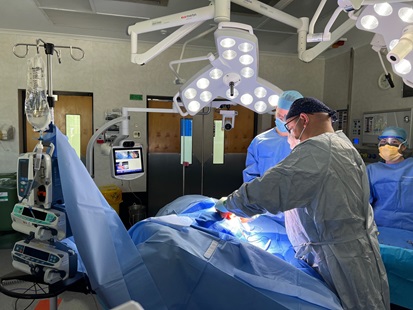2025 | Volume 26 | Issue 4
Author: Dr. Chris Lewis, FRACS – Director of Surgery, Rockhampton Base Hospital QLD
With inputs from:
Dr. Michael Lamparelli, FRACS – Consultant General Surgeon, Rockhampton Base Hospital, QLD
Dr. Leanne Stroud, FRACS – Consultant General Surgeon, Rockhampton Base Hospital, QLD
Dr. Craig Winter, FRACS – Consultant Neurosurgeon, Royal Brisbane and Women’s Hospital, QLD
It was around 8pm when I finally sat down with a beer, all ’Dad’s taxi‘ duties complete and the children returned safely from the usual sporting activities of soccer, netball etc. I wasn’t on-call, and didn’t need to drive, so the second beer soon followed. It was then that I received the call from my colleague, Michael Lamparelli. “I have just been called by our neurosurgical colleague in Brisbane, and he has advised that there is an acute extradural haemorrhage in the emergency department (ED). Can you help? I am out of town,” he said.
I am sure this scenario is not unique. In this case, Michael and I had received training from the proactive neurosurgical team at the Royal Brisbane Hospital on how to perform an emergency craniotomy for such cases. Unfortunately, our team of surgeons in Rockhampton had not had the opportunity to attend the course yet, so the experience and skills were limited to us.
On this particular Friday evening neither of us were in a position to perform the necessary operation. This was a time dependant condition with a degrading prognosis for every hour the surgical decompression was not achieved. The realistic transfer time from Rockhampton ED to theatres at the Royal Brisbane Hospital is around four hours at best, so this patient was in trouble.
Unfortunately, this can be an all-too-common situation in rural Australia. Since it's neither practical nor realistic to have a neurosurgical unit—or many other surgical subspecialties—in every town, the question becomes: how do we save lives when geography is the biggest killer? Fortunately, we had a solution. Through charitable donations and the dogged determination of my colleague, Michael Lamparelli, the hospital had acquired the Teladoc remote surgical system. This arrangement of monitors, cameras and audio communication allows close observation and supervision of procedures and operations through the ether. It brings expert knowledge, judgement and experience directly into theatre from the specialist centre, hundreds or thousands of kilometres away.
Rockhampton has welcomed this system. Primarily, the plan is to support our other, more remote, health service sites in Gladstone, Longreach and Emerald, where advice and support can be provided from the base hospital in a hub and spoke fashion to the more rural sites.
Teledoc preparation, Emerald theatres
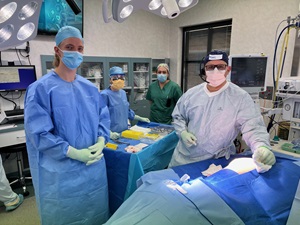
Teledoc audio connected
In this situation, the base hospital called for help and it was provided. With a smart phone and laptop connection, Dr Craig Winter the neurosurgeon on-call, advised and supervised the general surgical consultant, Dr. Leanne Stroud, in real time. With the assistance of the orthopaedic consultant, a decompressive craniectomy was performed—evacuating the haematoma and arresting the bleeding.
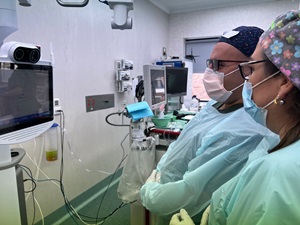
Realtime discussion with offsite specialists
This damage control surgery was vital in providing time to transfer for a definitive operation in the specialist centre hundreds of kilometres away. It is clear this patient’s life was saved, and long-term neurological damage minimised by the prompt action and coordination of the multicentre teams across Queensland. Despite the transfer team being on site and the aircraft on standby, it took a further five hours before the patient was received in Brisbane. This delay would almost certainly have caused catastrophic damage to the patient.
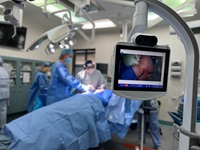
Teledoc optical feed
This experience was our first with the use of Teladoc. The system had only recently been installed and trials with our outreach hospitals were in their infancy, but this situation required prompt action and improvisation. Thankfully, the internet links and the bandwidth from the hospital Wi-Fi were successful, and the procedure was completed in around one hour. At each stage, the support and advice from the expert allowed confident decision making and operative technique, without the specialist being in the room. We believe this is the first occasion when such a system has been employed in a public hospital in Australia.
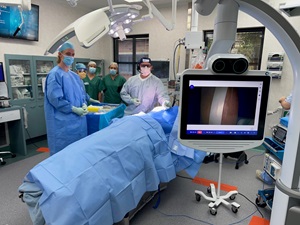
All finished
There are multiple uses for this system in rural Australia. Although its use in theatre for unexpected complex superspecialist surgery or emergency operations—where the surgeon’s experience may be limited—is the most obvious scenario, there are many other situations where it can be effectively employed.
With specialist interest GP’s performing surgery in more remote areas, the potential for the operator to suddenly encounter unexpected pathology or complications is real. With this system available, the clinician can receive advice and support for resolution of the emergency even with a reduced level of personal experience at the site of surgery. The involvement of technology, in this fashion, has created the ability for safer and more diverse operations to be performed in rural Australia. In the emergent situation, we have demonstrated with only basic surgical technique, lives can be saved with the input of a specialist who can supervise from afar. Our first craniotomy patient has survived and is well on his way to getting home with the help of the rehabilitation unit.
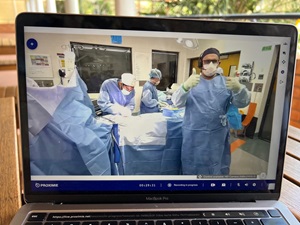
View from the kitchen table
The Teladoc system uses a high-resolution camera on a boom to allow the remote surgeon to visualise the situation. With integrated theatre systems, the laparoscopic camera can directly connect showing the normal operative field. Connection to the audio system will let the remote advisor provide instructions to the operator and observe the outcome of that advice from anywhere in the state, country or world.
As a teaching aid, it enables the trainer to remain outside the theatre while keeping a close, supportive eye on the Trainee. This is an important step to creating the independent operator that we strive to achieve through regional training programs.
It is impossible and impractical to have a world class expert in every operating theatre, in every town in Australia, but Teladoc will make it a possibility. With expansion of this system throughout rural and metropolitan Australia patients will receive the safest and best surgical care possible in their local environment—closer to home. Geographical isolation need not be a death sentence in major trauma or illness, as advice will be on the other end of the camera.
We will expand our use regionally and hope to provide the better and safer surgical care in central Queensland as a result.
If you have any questions or want to connect email me: [email protected]
With Prof Owen Ung
